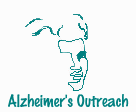 Reality
Orientation
Reality
Orientation
By Doreen Kotik-Harper and Robert G. Harper
 Reality
Orientation
Reality
Orientation
By Doreen Kotik-Harper and Robert G. Harper
If you would
like to print it out in plain text, click HERE
As disorientation about surroundings and the passage of time increases, confusion, frustration, or anxiety may cause withdrawal from others and result in less interaction with the environment and other patients.
For the Alzheimer's patient, whose thinking processes are already slowed and impaired, a treatment approach called reality orientation was developed. Reality orientation is based upon the belief that continual, repetitive reminders will keep the patient stimulated and lead to an increase in orientation.
Though in order for reality orientation to be effective, reorienting techniques must be applied consistently by all of the people who come into contact with the patient, twenty four hours a day.
This requirement is more difficult than it sounds, as constant repetition and drilling of simple information can become boring and frustrating. However, by making the reality training creative, it can turn a task, into a satisfying experience for all of those involved.
Some general guidelines do need to be kept in mind.
Foremost among them is this: Treat the patient with respect and dignity at all times and address the patient as though you expect him or her to understand.
Recognize the individual's level of capability, but remember that you are dealing with an adult who should not be talked down to or treated as a child.
Attempt to mention names of familiar people and objects, as well as the current date, the week, and the time of day in all conversations with the confused patient.
Encourage attempts at personal care; doing the basic activities of daily living keeps the confused person in touch with reality.
Reward the AD patient's attempts to increase awareness, and correct personal comments or those about the surroundings with a smile or a compliment.
Materials Used to Enhance Orientation Materials for encouraging reorientation and re-learning are easy to find and need not be expensive.
A large clock and a calendar should be visible at all times. Earlier stage Alzheimer's patients can and should be encouraged to wear and use a watch that contains a date feature.
Stimulating materials should be readily available for the patient, such as current newspapers and magazines.
A schedule of daily activities should be posted throughout the hallway which include the time and the date.
To help keep the patient oriented to place, signs, directional arrows, night lights, or color-coded doors may be helpful.
A standard prop employed in reality orientation classes is the reality orientation board. The type of board used can be cork bulletin board, pegboard, a felt board, a blackboard, or any surface that allows for an easy changing of information on a daily basis.
A typical format for the reality board would be:
Today is:
The date is:
The Year is:
The weather today is:
The next holiday is:
The next meal is:
It is imperative that the reality board be kept current and correct.
Other materials can include;
*a clock with moveable hands;
*photo albums and scrapbook;
*large print books;
*scrabble sets,
*county, state, and world maps;
*well-known landmarks or a United States map or world globe.
It must be noted that every Alzheimer's patient has different strengths and weaknesses that change over time, and even vary from day to day. As such, it is up to the primary orientation personal to decide which orienting and training techniques will be suitable for that day.
It is however, possible to divide the orientation.
For instance:
For the higher functioning patients in the earlier stages of the disease, discussions of current events and newspaper headlines, working on simple crossword puzzles, or fill in the blank statements may be appropriate.
A moderately affected patient may be able to discuss such topics as recipes, sports, or television shows.
For the severely affected and confused patient, the personal may do best to focus on constant repetition of personal information, name, etc.
They may also benefit from the review of colors, names of objects and such.
*** The key to reality orientation is repetition and reminders offered in a positive way. ***
The primary goals of this technique is to rebuild the patient's self-esteem, self- confidence and the restoration of personal dignity.
(C) copyright 1996

Hope our logo helps you find your way back to us.